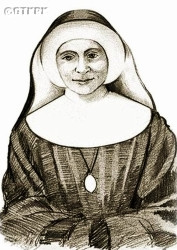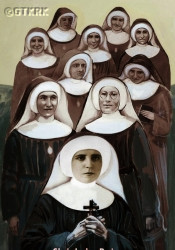Roman Catholic
St Sigismund parish
05-507 Słomczyn
85 Wiślana Str.
Konstancin deanery
Warsaw archdiocese, Poland
full list:
displayClick to display full list

searchClick to search full list by categories
wyświetlKliknij by wyświetlić pełną listę po polsku

szukajKliknij by przeszukać listę wg kategorii po polsku

Martyrology of the clergy — Poland
XX century (1914 – 1989)
personal data
religious status
blessed
surname
THIENEL
forename(s)
Anne (pl. Anna)
religious forename(s)
Sabine (pl. Sabina)

function
nun
creed
Latin (Roman Catholic) Church RCmore on
en.wikipedia.org
[access: 2014.09.21]
congregation
Congregation of Sisters of st Elizabeth CSSEmore on
en.wikipedia.org
[access: 2013.05.19]
(i.e. St Elizabeth Sisters)
diocese / province
Wrocław archdiocesemore on
en.wikipedia.org
[access: 2013.05.19]
date and place
of death
01.03.1945

Lubańtoday: Lubań urban gm., Lubań pov., Lower Silesia voiv., Poland
more on
en.wikipedia.org
[access: 2021.04.02]
details of death
In 1944 evacuated with religious co‐sisters and old peoples they tended from Wrocław to the St Anthony boarding school in Lubań.
In 01.1945, during final Russian winter push of the World War II — started by German and Russian invasion of Poland in 09.1939 — during German troop withdrawal in the face of Russian offensive decided to stay behind with her wards.
On 28.02.1945, during the battles of Lubań (Russians captured the town on 28.02.1945, to lose it on 08.03.1945, and recapture on 08.05.1945), when Russians entered the building a violent rapes started.
One Russian soldier wanted Sr Sabine to drag out but she resisted holding fast to a cross.
The soldier relented and left.
Next day on 01.03.1945 Russians forced everybody to leave the building except religious sisters.
Then was hit by a bullet through a closed door and perished on the spot.
cause of death
extermination: rape and murder
perpetrators
Russians
sites and events
Mass rapes in 1945Click to display the description, Ribbentrop‐MolotovClick to display the description, Pius XI's encyclicalsClick to display the description
date and place
of birth
24.09.1909

Rudziczkatoday: Prudnik gm., Prudnik pov., Opole voiv., Poland
more on
en.wikipedia.org
[access: 2021.04.02]
parents
THIENEL Andrew
🞲 1872, ? — 🕆 1948, ?

HERRMANN Anne
🞲 1874, ? — 🕆 1956, ?
baptism
01.10.1909

Rudziczkatoday: Prudnik gm., Prudnik pov., Opole voiv., Poland
more on
en.wikipedia.org
[access: 2021.04.02]
Holy Trinity RC church
religious vows
24.10.1934 (temporary)
31.07.1940 (permanent)
positions held
1944 – 1945
nun — Lubańtoday: Lubań urban gm., Lubań pov., Lower Silesia voiv., Poland
more on
en.wikipedia.org
[access: 2021.04.02] ⋄ St Anthony Congregation's house, St Elizabeth Sisters CSSE
1936 – 1944
nun — Wrocławtoday: Wrocław city pov., Lower Silesia voiv., Poland
more on
en.wikipedia.org
[access: 2021.04.02] ⋄ St Nicholas General House, St Elizabeth Sisters CSSE — ministry in a nursing home
10.10.1933 – 1934
novitiate — Wrocławtoday: Wrocław city pov., Lower Silesia voiv., Poland
more on
en.wikipedia.org
[access: 2021.04.02] ⋄ novitiate house, St Elizabeth Sisters CSSE
22.02.1933
accession — St Elizabeth Sisters CSSE
others related
in death
ELLMERERClick to display biography Anne (Sr Felicitas), GOLDBERGClick to display biography Helen (Sr Acutina), HEYMANNClick to display biography Lucy (Sr Sapientia), JAHNClick to display biography Mary Magdalene (Sr Paschalis), KUBITZKIClick to display biography Juliana (Sr Edelburgis), RYBKAClick to display biography Martha (Sr Melusia), SCHILLINGClick to display biography Alfreda (Sr Rosaria), SCHRAMMClick to display biography Claire (Sr Adele), TÖPFERClick to display biography Hedwig (Sr Adelheidis), WITKOWSKAClick to display biography Marianne (Sr Mary Theodora)
sites and events
descriptions
Mass rapes in 1945: During capture in 1944‐1945 of pre‐war German territories and territories incorporated into Germany in 1939 after German invasion of Poland Russian soldiers committed mass, often multiple, rapes on mainly German, but also Polish, women. Up to 2 mln women might have been violated, from 8 to 80 or more years old. Many were murdered as a consequence. Rapes were prob. tolerated if not encouraged by Russian military and civilian NKVD commanders. (more on: en.wikipedia.orgClick to attempt to display webpage
[access: 2015.03.01])
Ribbentrop‐Molotov: Genocidal Russian‐German alliance pact between Russian leader Joseph Stalin and German leader Adolf Hitler signed on 23.08.1939 in Moscow by respective foreign ministers, Mr. Vyacheslav Molotov for Russia and Joachim von Ribbentrop for Germany. The pact sanctioned and was the direct cause of joint Russian and German invasion of Poland and the outbreak of the World War II in 09.1939. In a political sense, the pact was an attempt to restore the status quo ante before 1914, with one exception, namely the „commercial” exchange of the so‐called „Kingdom of Poland”, which in 1914 was part of the Russian Empire, fore Eastern Galicia (today's western Ukraine), in 1914 belonging to the Austro‐Hungarian Empire. Galicia, including Lviv, was to be taken over by the Russians, the „Kingdom of Poland” — under the name of the General Governorate — Germany. The resultant „war was one of the greatest calamities and dramas of humanity in history, for two atheistic and anti‐Christian ideologies — national and international socialism — rejected God and His fifth Decalogue commandment: Thou shall not kill!” (Abp Stanislav Gądecki, 01.09.2019). The decisions taken — backed up by the betrayal of the formal allies of Poland, France and Germany, which on 12.09.1939, at a joint conference in Abbeville, decided not to provide aid to attacked Poland and not to take military action against Germany (a clear breach of treaty obligations with Poland) — were on 28.09.1939 slightly altered and made more precise when a treaty on „German‐Russian boundaries and friendship” was agreed by the same murderous signatories. One of its findings was establishment of spheres of influence in Central and Eastern Europe and in consequence IV partition of Poland. In one of its secret annexes agreed, that: „the Signatories will not tolerate on its respective territories any Polish propaganda that affects the territory of the other Side. On their respective territories they will suppress all such propaganda and inform each other of the measures taken to accomplish it”. The agreements resulted in a series of meeting between two genocidal organization representing both sides — German Gestapo and Russian NKVD when coordination of efforts to exterminate Polish intelligentsia and Polish leading classes (in Germany called «Intelligenzaktion», in Russia took the form of Katyń massacres) where discussed. Resulted in deaths of hundreds of thousands of Polish intelligentsia, including thousands of priests presented here, and tens of millions of ordinary people,. The results of this Russian‐German pact lasted till 1989 and are still in evidence even today. (more on: en.wikipedia.orgClick to attempt to display webpage
[access: 2015.09.30])
Pius XI's encyclicals: Facing the creation of two totalitarian systems in Europe, which seemed to compete with each other, though there were more similarities than contradictions between them, Pope Pius XI issued in 03.1937 (within 5 days) two encyclicals. In the „Mit brennender Sorge” (Eng. „With Burning Concern”) published on 14.03.1938, condemned the national socialism prevailing in Germany. The Pope wrote: „Whoever, following the old Germanic‐pre‐Christian beliefs, puts various impersonal fate in the place of a personal God, denies the wisdom of God and Providence […], whoever exalts earthly values: race or nation, or state, or state system, representatives of state power or other fundamental values of human society, […] and makes them the highest standard of all values, including religious ones, and idolizes them, this one […] is far from true faith in God and from a worldview corresponding to such faith”. On 19.03.1937, published „Divini Redemptoris” (Eng. „Divine Redeemer”), in which criticized Russian communism, dialectical materialism and the class struggle theory. The Pope wrote: „Communism deprives man of freedom, and therefore the spiritual basis of all life norms. It deprives the human person of all his dignity and any moral support with which he could resist the onslaught of blind passions […] This is the new gospel that Bolshevik and godless communism preaches as a message of salvation and redemption of humanity”… Pius XI demanded that the established human law be subjected to the natural law of God , recommended the implementation of the ideal of a Christian state and society, and called on Catholics to resist. Two years later, National Socialist Germany and Communist Russia came together and started World War II. (more on: www.vatican.vaClick to attempt to display webpage
[access: 2023.05.28], www.vatican.vaClick to attempt to display webpage
[access: 2023.05.28])
sources
personal:
nowezycie.archidiecezja.wroc.plClick to attempt to display webpage
[access: 2013.05.19], newsaints.faithweb.comClick to attempt to display webpage
[access: 2013.05.19], www.elzbietankipoznan.plClick to attempt to display webpage
[access: 2015.09.30], thema.erzbistum-koeln.deClick to attempt to display webpage
[access: 2018.05.06]
bibliographical:
„Opole Silesia clergy's martyrology during Silesian Uprisings and the II World War”, Fr Andrew Hanich, Opole 2019
original images:
elzbietanki.wroclaw.plClick to attempt to display webpage
[access: 2018.05.06], elzbietanki.wroclaw.plClick to attempt to display webpage
[access: 2018.05.06]
LETTER to CUSTODIAN/ADMINISTRATOR
If you have an Email client on your communicator/computer — such as Mozilla Thunderbird, Windows Mail or Microsoft Outlook, described at WikipediaPatrz:
en.wikipedia.org, among others — try the link below, please:
LETTER to CUSTODIAN/ADMINISTRATORClick and try to call your own Email client
If however you do not run such a client or the above link is not active please send an email to the Custodian/Administrator using your account — in your customary email/correspondence engine — at the following address:

giving the following as the subject:
MARTYROLOGY: THIENEL Anne
To return to the biography press below:
 Click to return to biography
Click to return to biography










